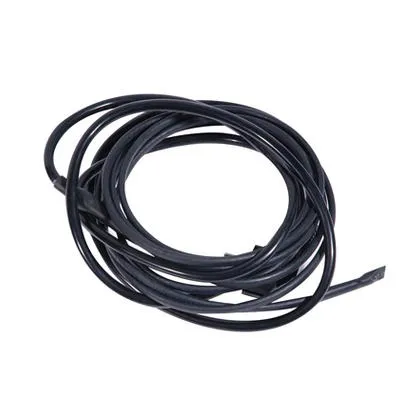Airport operations become more challenging as climate change increases weather uncertainty. During cold weather conditions, snow and ice can have serious impacts on the safety and availability of airport runways. In order to solve these problems, heating cable technology is widely used in airport runways to ensure the safety and smoothness of aircraft takeoff and landing.

1. Application of heating cable technology
1). Snow melting and deicing: The heating cable is embedded in the underground of the airport runway, and the cable is heated by power supply, thereby maintaining the runway surface at a suitable temperature. This prevents the formation of snow and ice, improves the robustness and usability of the runway, and reduces the risk of taxiing accidents.
2). Anti-freeze ground: In cold areas, underground water pipes and underground facilities may freeze due to low temperatures. Heating cables are used to prevent the ground from freezing and ensure the normal operation of airport infrastructure.
3). Runway lighting: Some heating cables also integrate lighting functions, allowing airport runways to remain visible under adverse weather conditions and providing necessary support for the safe takeoff and landing of aircraft.
4). Intersection heating: The intersection of airport runways is a place where snow and ice often accumulate. By installing heating cables at intersections, these critical areas can be kept clear and the risk of accidents avoided.
5). Fuel pipeline heating: The airport needs to supply fuel to the aircraft. In cold climates, fuel lines can freeze, affecting supply. Heating cables can be used to heat fuel pipes to ensure a smooth supply of fuel.
2. Advantages and benefits
1). Improved safety: Heating cable technology can significantly reduce the risk of runway taxiing accidents caused by snow and ice, improving the safety of airport operations.
2). Increased availability: Snow melting and de-icing can keep the runway open, ensuring it is always available and reducing flight delays.
3). Reduced maintenance costs: By preventing the formation of ice and ice, heating cables can reduce maintenance costs for runways and facilities.
4). Environmentally friendly: Using heating cables for snow melting and deicing can reduce reliance on chemical snow melting agents, thereby reducing the impact on the environment.

In short, the application of Electric heating cable technology on airport runways provides strong support for airport operations. By keeping runways dry and warm, this technology ensures safe takeoffs and landings and increases the efficiency and reliability of airport operations. In the future, as technology continues to develop, heating cable technology will continue to play a key role in creating a safer and more sustainable environment for airport operations.

 English
English Español
Español Português
Português русский
русский français
français 日本語
日本語 Deutsch
Deutsch Tiếng Việt
Tiếng Việt Italiano
Italiano Nederlands
Nederlands ไทย
ไทย Polski
Polski 한국어
한국어 Svenska
Svenska magyar
magyar Malay
Malay বাংলা
বাংলা Dansk
Dansk Suomi
Suomi हिन्दी
हिन्दी Pilipino
Pilipino Türk
Türk Gaeilge
Gaeilge عربى
عربى Indonesia
Indonesia norsk
norsk اردو
اردو čeština
čeština Ελληνικά
Ελληνικά Українська
Українська Javanese
Javanese فارسی
فارسی தமிழ்
தமிழ் తెలుగు
తెలుగు नेपाली
नेपाली Burmese
Burmese български
български ລາວ
ລາວ Latine
Latine Қазақ
Қазақ Euskal
Euskal Azərbaycan
Azərbaycan slovenský
slovenský Македонски
Македонски Lietuvos
Lietuvos Eesti Keel
Eesti Keel Română
Română Slovenski
Slovenski मराठी
मराठी Српски
Српски 简体中文
简体中文 Esperanto
Esperanto Afrikaans
Afrikaans Català
Català עִברִית
עִברִית Cymraeg
Cymraeg Galego
Galego 繁体中文
繁体中文 Latvietis
Latvietis icelandic
icelandic יידיש
יידיש Беларус
Беларус Hrvatski
Hrvatski Kreyòl ayisyen
Kreyòl ayisyen Shqiptar
Shqiptar Malti
Malti lugha ya Kiswahili
lugha ya Kiswahili አማርኛ
አማርኛ Bosanski
Bosanski Frysk
Frysk ជនជាតិខ្មែរ
ជនជាតិខ្មែរ ქართული
ქართული ગુજરાતી
ગુજરાતી Hausa
Hausa Кыргыз тили
Кыргыз тили ಕನ್ನಡ
ಕನ್ನಡ Corsa
Corsa Kurdî
Kurdî മലയാളം
മലയാളം Maori
Maori Монгол хэл
Монгол хэл Hmong
Hmong IsiXhosa
IsiXhosa Zulu
Zulu Punjabi
Punjabi پښتو
پښتو Chichewa
Chichewa Samoa
Samoa Sesotho
Sesotho සිංහල
සිංහල Gàidhlig
Gàidhlig Cebuano
Cebuano Somali
Somali Точик
Точик O'zbek
O'zbek Hawaiian
Hawaiian سنڌي
سنڌي Shinra
Shinra հայերեն
հայերեն Igbo
Igbo Sundanese
Sundanese Lëtzebuergesch
Lëtzebuergesch Malagasy
Malagasy Yoruba
Yoruba









